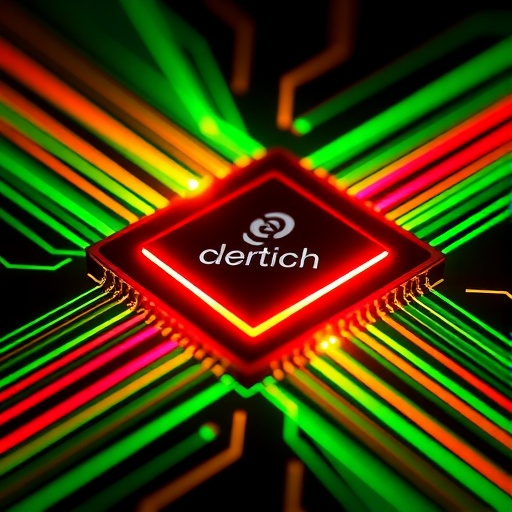
In the relentless pursuit of advancing integrated photonics, the mid-infrared (mid-IR) spectrum—ranging from 3 to 12 micrometers in wavelength—has remained a particularly challenging frontier. This specifically pertains to compact, efficient, and robust sources capable of producing ultrafast pulses, which are essential for applications spanning molecular spectroscopy, environmental sensing, and nonlinear optics. Conventional approaches rely heavily on bulky, complex downconversion systems where near-infrared or visible laser pulses are nonlinearly converted to the desired mid-IR range. These systems are often power-hungry, unstable, and incompatible with scalable on-chip technology. However, a transformative stride has been recently unveiled: a semiconductor laser chip capable of directly generating bright soliton pulses in the mid-infrared, driven purely by direct current, with no need for external modulators or complex nonlinear conversion stages. This breakthrough holds the promise of revolutionizing mid-IR photonics by dramatically shrinking device footprints while enhancing performance and operational stability.
At the core of this innovation lies the generation of solitons—self-reinforcing, localized wave packets that maintain their shape as they propagate due to a balance between dispersion and nonlinear effects within the medium. While solitons are well-established in passive nonlinear Kerr resonators, such as silica microresonators, their realization inside active laser systems has posed significant challenges. The reported system ingeniously exploits a fast bistability inherent to active nonlinear laser resonators. Unlike traditional mode-locking techniques that rely on saturable absorbers or gain modulation, this laser chip leverages intrinsic nonlinearities within the active region itself. This subtle yet fundamental difference allows for the spontaneous formation of stable, bright solitons at GHz repetition rates without the complexity of external modulation or passive nonlinear elements.
This device comprises a monolithic integration of several key components on a single chip: the drive laser, an active ring resonator, a coupler, and a pump filter. Such integration ensures a compact footprint and turnkey operation, where bright solitons emerge and sustain themselves robustly for hours under continuous operation, all without requiring active stabilization. The implications of this extend beyond just device convenience—stability and reproducibility are notoriously difficult to achieve in short-pulse, mid-IR sources, particularly when traditional bulky mode-lockers or external stabilization apparatuses are involved. This chip’s autonomous nature may well pave the way for widespread adoption in commercial and industrial photonics applications.
One of the most compelling features of this system is its ability to generate pulses with durations on the order of one picosecond, centered precisely at 8.3 micrometers wavelength. This wavelength region is particularly rich in molecular absorption lines, which makes it extremely valuable for spectroscopic sensing of gases and chemicals, environmental monitoring, and even medical diagnostics. The generation of solitons in this spectral range on a semiconductor chip is unprecedented, breaking new ground that was previously thought inaccessible using conventional integrated photonics approaches. Manufacturing such devices in industrial laser foundries is fully compatible with standard fabrication protocols, promising scalability and cost-effectiveness essential for broad dissemination.
The physical mechanisms driving soliton formation in this active laser differ fundamentally from those in passive microresonators. In traditional Kerr resonators, solitons arise due to passive nonlinearities—chiefly the intensity-dependent refractive index modulation—balanced against intrinsic dispersion of the cavity. However, in the presented laser chip, active nonlinearities induced by gain saturation and refractive index changes at high carrier densities create a fast bistable response. This bistability enables a unique route to soliton formation that intrinsic saturable absorbers cannot achieve. This hybrid behavior effectively blends active and passive microresonator physics, unifying previously distinct paradigms within integrated photonics.
Further technical nuance lies in the laser chip’s architecture—a highly optimized active ring resonator that circulates light multiple times to enable nonlinear interaction strength adequate for soliton generation at remarkably low drive powers. The integrated coupler and pump filter serve critical roles in isolating the desired nonlinear dynamics and suppressing unwanted spectral components, ensuring pure and stable soliton emission. Such design intricacies underscore the meticulous craftsmanship in marrying semiconductor laser engineering with nonlinear dynamics, marking a milestone in photonic device innovation.
Operational stability is another salient highlight. Conventional mid-infrared pulse sources based on downconversion frequently suffer from thermal drifts, alignment sensitivity, and mode competition, severely limiting long-term operation without intervention. In contrast, the demonstrated device maintains bright soliton pulses continuously for hours, a testament to robust self-stabilization inherent in the active nonlinear architecture. This characteristic alone propels the technology into realms where high uptime, low maintenance, and device reliability are non-negotiable requisites—such as in field-deployable sensors and real-time chemical analyzers.
Beyond its immediate utility, this new platform invites a deeper understanding of laser dynamics and frequency comb physics. By bridging active semiconductor laser processes and passive Kerr resonator phenomena, researchers can explore novel regimes of nonlinear optics, frequency comb generation, and ultrafast dynamics that were inaccessible or impractical before. This convergence opens opportunities for tailoring nonlinear behavior via material engineering, geometry tuning, and drive conditions, potentially unlocking customizable pulse shaping and comb spectra directly on-chip.
The broader impact of this work touches various ambitious technological sectors. Mid-infrared photonics underpins crucial applications in security screening, breath analysis for health diagnostics, industrial process monitoring, and environmental surveillance. Traditionally, these fields have been constrained by the lack of compact, bright, stable, and inexpensive mid-IR sources. The ability to produce picosecond solitons from a semiconductor chip directly addresses these limitations, promising to democratize access and integration of mid-IR photonics into portable devices, drones, satellites, and handheld analyzers.
From a manufacturing standpoint, the compatibility of the reported device with existing industrial foundry workflows removes a critical bottleneck in transitioning from lab demonstrations to commercial products. This monolithic integration mirrors the semiconductor industry’s standards, enabling mass production, quality control, and reproducibility at scale. It markedly contrasts with conventional mid-IR laser technologies, which often require intricate assembly, specialized nonlinear crystals, or cryogenic environments. This breakthrough marks an inflection point where mid-IR frequency combs leap from experimental curiosities to practical workhorse instruments.
Looking forward, the research community anticipates rapid developments, including extending spectral coverage deeper into the long-wave infrared, engineering multi-soliton states for high comb line counts, and integrating detection and signal processing modules on the same chip. The underlying physical principles demonstrated hint at a versatile platform adaptable to other wavelength regimes, potentially inspiring a new generation of chip-scale frequency combs across the electromagnetic spectrum. Such innovations will likely catalyze interdisciplinary applications—for instance, in quantum photonics, telecommunications, and ultrafast spectroscopy—beyond the immediate mid-infrared focus.
In summary, the realization of bright, stable, picosecond solitons directly from a DC-driven semiconductor laser chip marks a paradigm shift in mid-infrared photonics. It elegantly combines state-of-the-art integrated laser design, nonlinear optics, and material science to overcome longstanding obstacles in spectral coverage, pulse duration, device complexity, and stability. This technology promises not just incremental progress but a new chapter where mid-IR ultrafast photonics become scalable, accessible, and sustainably manufacturable, fostering innovations that reverberate across science, industry, and everyday technology.
Subject of Research: Mid-infrared integrated photonics; semiconductor laser solitons; nonlinear optics; frequency combs.
Article Title: Driven bright solitons on a mid-infrared laser chip.
Article References:
Kazakov, D., Letsou, T.P., Piccardo, M. et al. Driven bright solitons on a mid-infrared laser chip. Nature (2025). https://doi.org/10.1038/s41586-025-08853-y
Image Credits: AI Generated
Tags: active laser systems challengesbright solitons in photonicscompact mid-IR sourcesenvironmental sensing applicationsmid-infrared laser technologymolecular spectroscopy techniquesnonlinear optics advancementson-chip photonics solutionsscalable photonics technologyself-reinforcing wave packetssemiconductor laser chip innovationsultrafast pulse generation


